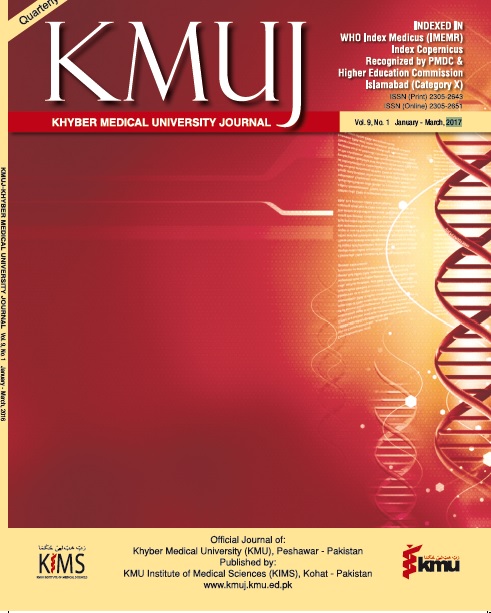HEMOPHILIA B DIAGNOSTIC DISCREPANCY: A SURVEY TO CONFIRM THE DIAGNOSIS OF HEMOPHILIA B
Main Article Content
Abstract
OBJECTIVES: To determine the frequency of misdiagnosis among documented factor IX (FI) deficient (hemophilia B) patients of Khyber Pakhtunkhwa (KP) province of Pakistan and to discern role of different diagnostic tests employed in this regard.
METHODS: Patients were identified through registries at transfusion centers. Out of 83 FIX deficient patients registered at transfusion centers and hemophilia care centers of KP province, 32 patients could be contacted and only 30 patients consented to be enrolled into the study. A comprehensive questionnaire depicting demographic details, clinical history and physical examination was filled out for each enrolled patient. Their blood samples were posed to first and second line coagulation tests both manually and on two different automated coagulation analyzers.
RESULTS: The registered FIX deficient patients’ pool was found to have a mean age of 17.39±9.8 years. Out of 30 enrolled patients, diagnosis was correct in 18 (60.0%) patients and wrong in 12 (40.0%) patients. The misdiagnosed cases were hemophilia-A (n=9; 30%) and hypo-fibrinogenemia (n=3; 10.0%). All cases diagnosed previously on the basis of factor assays (n=8, 100%) were found to be correct while those diagnosed previously with mixing studies, only 08/18 (44.44%) had FIX deficiency. Out of 4 cases diagnosed on circumstantial evidence of isolated prolonged APTT along with established FIX deficiency in another sibling or maternal cousin, 2 had FIX deficiency.
CONCLUSION: A large fraction of patients documented as FIX deficient on the basis of mixing studies are misdiagnosed. In clinical practice factor assays are more valid in comparison to mixing studies.
Key Words
Hemophilia B (MeSH), Factor IX Deficiency (Non-MeSH), Diagnostic Discrepancy (Non-MeSH), Mixing Studies (Non-MeSH)
Article Details
Work published in KMUJ is licensed under a
Creative Commons Attribution 4.0 License
Authors are permitted and encouraged to post their work online (e.g., in institutional repositories or on their website) prior to and during the submission process, as it can lead to productive exchanges, as well as earlier and greater citation of published work.
(e.g., in institutional repositories or on their website) prior to and during the submission process, as it can lead to productive exchanges, as well as earlier and greater citation of published work.
References
Stonebraker JS, Bolton-Maggs PH, Michael Soucie J, Walker I, Brooker M. A study of variations in the reported haemophilia B prevalence around the world. Haemophil¬ia 2012;18(3):e91-4.
Eshghi P, Mahdavi-Mazdeh M, Karimi M, Aghighi M. Haemophilia in the developing countries: the Iranian experience. Arch Med Sci 2010;6(1):83-9.
Srivastava A, Brewer AK, Mauser-Bun¬schoten EP, Key NS, Kitchen S, Llinas A, et al. Guidelines for the management of he¬mophilia. Haemophilia 2013;19(1):e1-47.
Hoffbrand AV, Catovsky D, Tuddenham EGD, Green AR: Postgraduate Haema¬tology. 6th ed. West Sussex: Wiley; 2010.
Darby SC, Kan SW, Spooner RJ, Gi¬angrande PL, Hill FG, Hay CR, et al. Mor¬tality rates, life expectancy, and causes of death in people with hemophilia A or B in the United Kingdom who were not infect¬ed with HIV. Blood 2007;110(3):815-25.
Lee CA. Hemophilia complications. Hep¬atitis C infection and its management. Haemophilia 2000; 6(s1):133-7.
Gilbert MS. Musculoskeletal complications of haemophilia: the joint. Haemophilia 2000; 6(s1):34-7.
Philipp C. The Aging Patient with He¬mophilia: Complications, Comorbidities, and Management Issues. ASH Education Program Book 2010;2010(1):191-6.
Plebani M. Errors in clinical laboratories or errors in laboratory medicine? Clin Chem Lab Med 2006; 44(6):750-9.
Makris M, Peyvandi F. Assaying FVIII activ¬ity: one method is not enough, and never was. Haemophilia 2014;20(3):301-3.
Cid AR, Calabuig M, Cortina V, Casana P, Haya S, Moret A, et al. One-stage and chromogenic FVIII:C assay discrepancy in mild haemophilia A and the relationship with the mutation and bleeding pheno¬type. Haemophilia 2008;14(5):1049-54.
Bowyer AE, Van Veen JJ, Goodeve AC, Kitchen S, Makris M. Specific and global coagulation assays in the diagnosis of discrepant mild hemophilia A. Haema¬tologica 2013; 98:1980-7. doi: 10.3324/ haematol.2013.088088. Epub 2013 Jun 28.
Khanum F, Collins P, Bowen DJ. Diagnosis of haemophilia in Pakistan: current picture. J Coll Physicians Surg Pak 2013;23(6):450- 1.
Lee CA, Berntorp EE, Hoots WK: Text¬book of Hemophilia. 3rd ed. West Sussex: Wiley; 2014.
Kitchen S, McCraw A, Echenagucia M: Diagnosis of Hemophilia and Other Bleed¬ing Disorders. 2nd ed. Canada: World Federation of Hemophilia; 2010. 45-8 p.
Plebani M. The detection and prevention of errors in laboratory medicine. Ann Clin Biochem 2010; 47(2):101-10.
Lippi G, Chance JJ, Church S, Dazzi P, Fontana R, Giavarina D, et al. Preanalyt¬ical quality improvement: from dream to reality. Clin Chem Lab Med 2011; 49(7):1113-26.
Plebani M. Exploring the iceberg of errors in laboratory medicine. Clin Chim Acta 2009; 404(1):16-23.
Franchini M, Mannucci PM. The history of hemophilia. Semin Thromb Hemost 2014 Jul;40(5):571-6. doi: 10.1055/s-0034- 1381232. Epub 2014 Jun 9.
Oldenburg J, Dolan G, Lemm G. Haemo¬philia care then, now and in the future. Haemophilia 2009;15(s1):2-7.
Mannucci PM. Back to the future: a recent history of haemophilia treatment. Haemo¬philia 2008;14(s3):10-8
Kulkarni R, Soucie JM, Lusher J, Presley R, Shapiro A, Gill J, et al. Sites of initial bleed¬ing episodes, mode of delivery and age of diagnosis in babies with haemophilia diag¬nosed before the age of 2 years: a report from The Centers for Disease Control and Prevention’s (CDC) Universal Data Collection (UDC) project. Haemophilia 2009;15(6):1281-90.
Doolin PJ: Medical Assisting Made Incredi¬bly Easy: Lab Competencies. Philadelphia: Lippincott Williams & Wilkins; 2007.
Esteridge BH, Reynolds AP, Walters NJ: Basic Medical Laboratory Techniques. 4th ed. Boston: Cengage Learning; 2000.
Jones SL: Clinical Laboratory Pearls. 1st ed. Philadelphia: Lippincott Williams & Wilkins; 2001.
